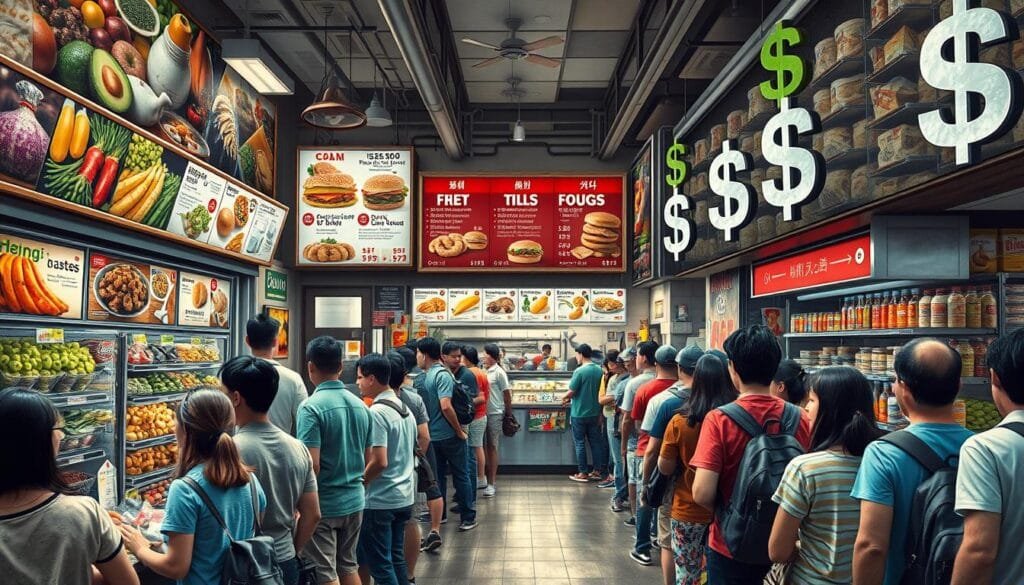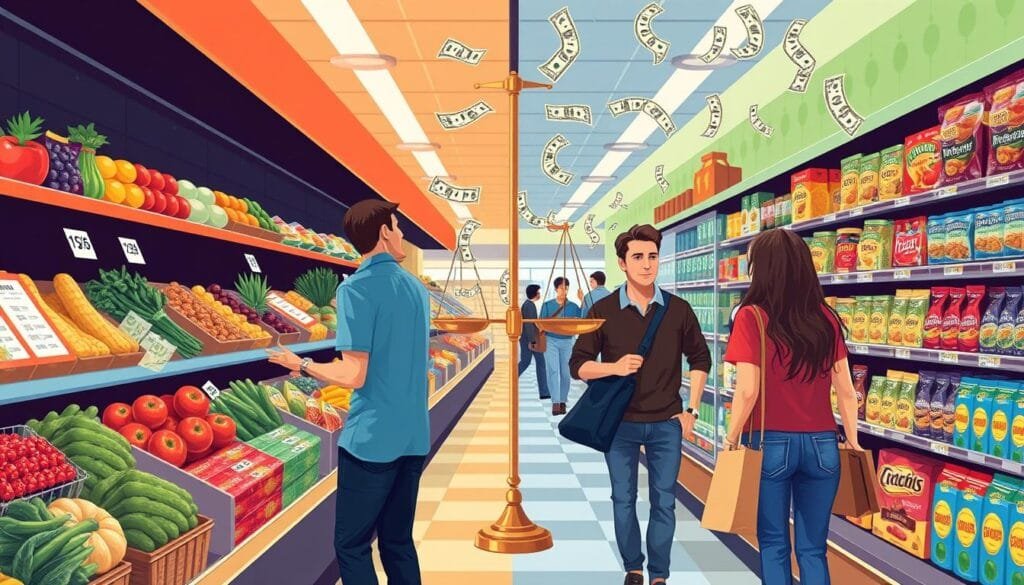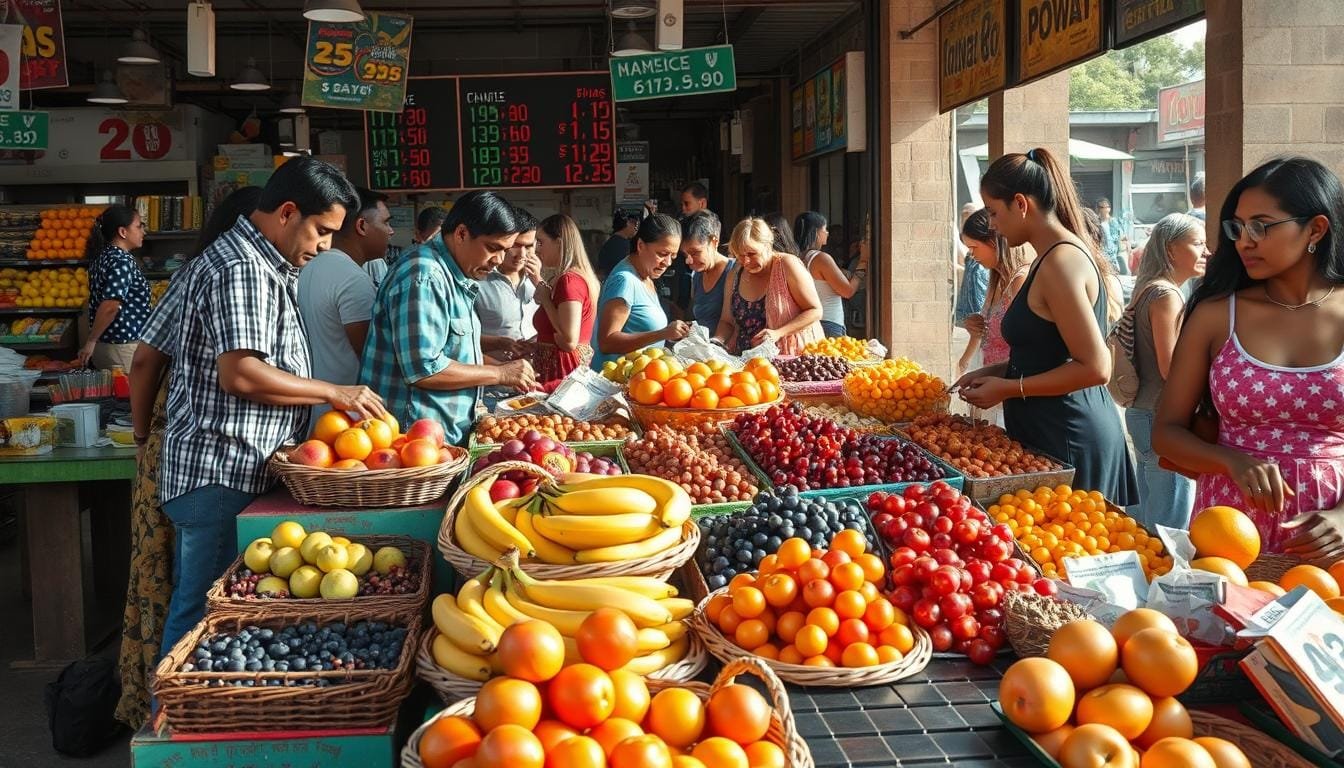We discover how food economics significantly affect what we eat. The influence of economics on diet is about more than just taste. It reveals how income and social status connect to the food we choose daily. High income usually means better access to healthy foods. People with more money often eat healthier. They focus on foods that keep them well and at a good weight.
But not everyone can afford this. Those with less money might not eat as healthily. This is due to both limited funds and a busy life. Education on nutrition and healthy eating is also important. Yet, understanding economic impacts on our diet requires looking at the big picture. It’s more than just about having money. Our food choices are influenced by various social and economic factors.
Looking closer, we find interesting facts. In some studies, students ate more fruit at school. But they didn’t eat more vegetables or low-fat milk. One’s economic status impacts what and how they’re willing to try new foods. People with less money often pick high-calorie but low-nutrient foods to save money. On the other hand, wealthier families try new foods more often. So, economics shapes not only what we eat but also our overall health.
Key Takeaways
- Income disparities significantly dictate access to nutritious foods.
- The proverbial cost of health: a healthy diet is inherently more expensive than its less healthy counterparts.
- Children’s food acceptance can be influenced by persistence, which is often a privilege afforded by greater financial resources.
- Parental dietary patterns and socioeconomic status are integral in the development of a child’s eating habits.
- Interventions aimed at reducing the cost of healthy food items can lead to a substantial increase in consumption.
- The hidden costs of dietary choices: chronic diseases burden individuals with increased healthcare expenses.
- Behavioral economics strategies can influence positive changes in fruit selection within educational settings.
Understanding the Basis of Food Economics
At its heart, the topic of food economics definition plays a key role. It goes beyond just our food choices. It looks at why and how our diets change with economic conditions. This exploration reveals its big impact on socioeconomic health.
Defining Food Economics and Its Importance
Food economics looks at the choices and actions related to food’s production, sharing, and use. Grasping the importance of food economics helps us find ways for everyone to make healthy food choices affordably. It aims for a world where eating well is possible for all, not just a select few.
Exploring the Historical Perspective of Food Choices
Reviewing the historical food choices shows us how diet has evolved over time and place. These choices were tied to the social and economic settings back then. Reflecting on history guides us in shaping better food strategies today, aiming to fix or enhance our eating habits.
- Economic Framework: Learning about food economics sheds light on why there’s such a gap in what people can eat.
- Socioeconomic Health: There’s a clear link between wealth, or lack of it, and health, especially in diet-related illnesses.
- Behavioral Economics: Showing calories on menus is one smart way to nudge us towards better food choices, highlighting how our decisions are influenced by many factors.
As we dig into food economics, we aim to use this knowledge to ensure everyone can enjoy healthy food. This will help improve overall well-being and economic health in societies everywhere.
The Role of Income in Dietary Decisions
The income disparities greatly affect what people can eat. For some, the high cost of healthy foods makes them hard to buy. This leads to a direct link between how much money people have and their food choices. Income levels and diet are closely connected, affecting public health deeply.
Income Disparities and Access to Nutritious Food
Families with more money often eat better, data shows. They tend to have higher vegetable and dairy scores. This proves that income affects diet quality directly. For more insights, check out the research on socio-economic disparities and diet.
The Price Gap between Healthy and Unhealthy Foods
The differences in how much families can spend on food are telling. About 8% of a typical family’s income goes to the Thrifty Food Plan. This shows how much budget families dedicate to eating healthy. The cost issue spans all regions, affecting food choice greatly.
Lower-income families feel this cost issue even more. They spend a smaller part of their budget on food, including less on treats like ice cream. This highlights the tough choices they make due to less money.
| Income Level | Vegetable Score | Dairy Score | % of Grocery on Non-Essentials |
|---|---|---|---|
| Higher Income | 3.6 | 5.6 | 3% |
| Lower Income | 2.3 | 5.0 | 1% |
To help, we need policies that lower economic barriers. This will give everyone access to better food. Without such change, diet quality gaps will remain, hurting lower-income groups more.
How Geography Affects Food Accessibility
Geographical factors significantly shape what people eat and their access to food. In places with poor geographic food accessibility, known as food deserts, it’s hard for residents to eat healthily.
Food Deserts and Their Impact on Food Choices
Both urban and rural areas can be food deserts where healthy, affordable food is scarce. Regions with high poverty often lack neighborhood food options. This situation affects people’s diets and health. USDA research emphasizes the need to tackle these issues.
The Influence of Urban vs. Rural Settings on Diet
Urban vs rural dietary differences are clear. Urban areas might have more stores, but they’re not always easy to reach. Rural areas usually have fewer grocery stores. People there often depend on small stores with limited healthy choices. This shows how geography deeply affects what communities eat.
Understanding these dynamics explains why getting healthy food is harder for some people. Below is a table showing the challenges in both urban and rural areas:
| Aspect | Urban | Rural |
|---|---|---|
| Basic Grocery Access | Limited in certain areas | Widely dispersed, often distant |
| Variety of Food Options | Highly variable, often processed foods | Limited options, lacks freshness |
| Impact of Food Deserts | High in densely populated yet under-served areas | High due to distance and lack of public transportation |
| Economic Impact | Food costs potentially higher in city centers | Higher travel costs to reach distant food sources |

This data and examples illustrate the complex issue of location affecting diet and health. They underline the importance of special policies and community efforts to overcome these challenges.
Time as a Factor in Making Food Choices
In our fast world, time factor food choices are shaped by our busy lifestyle diet impact. We often choose quick meals due to our packed schedules. This trend affects both our health and the economy, as convenience foods consumption and economic implications of fast food become intertwined.
The Role of Busy Lifestyles in Diet Quality
Because of time scarcity nutrition issues, finding time for cooking is hard. Research shows Americans spend about 33 minutes daily on food prep. This is much less than before.
Having little time increases our use of fast food. It’s usually less healthy. As a result, people eating out more tend to have poorer diets. These diets are high in calories but low in nutrients.
Convenience Foods and Their Economic Implications
Depending a lot on convenience foods has big economic consequences. These choices can lead to more health care costs. They also show how the economy of food has changed.
Home cooking often means eating better, like more fruits and veggies. On the other hand, fast food might be cheaper but lacks nutrients.
“Increased spending on home food preparation leads to better diet quality.”
This shows how food prep time and money spent eating out affect diet quality. It highlights the economic choices we make.
| Time Spent on Food Preparation | Average Money Spent on Food Away from Home | Diet Quality (HEI Score) |
|---|---|---|
| <1 hour/day | Higher | Low |
| 1–2 hours/day | Moderate | Moderate |
| >2 hours/day | Lower | High |

We need to balance time scarcity nutrition and healthy eating. This takes effort and system-wide support. Better access to healthy food that’s easy to make is key. As we deal with busy lives, making smarter food choices is vital for our health and wallet.
how does economics affect someone’s food choices simple
In our discussion about economic dietary factors, it’s clear that how much money families have greatly affects what they eat. When money is tight, they might choose cheaper, less healthy options. This shows a strong link between a family’s food budget nutrition and their health.
Looking at simple food choices economic effects, studies indicate that people’s decisions, especially regarding fruits and vegetables compared to unhealthy foods and drinks, are largely based on their budget. These choices are influenced by wider economic conditions that control access to good food.
| Food Type | Impact of Economic Factors (%) | Adjusted for Supermarket Choice (%) |
|---|---|---|
| Less-Healthy Foods/Beverages | 53 | 63 |
| Fruits and Vegetables | 36 | 31 |
The table shows how economic factors differently affect food choices, depending on where people shop. It highlights the challenges in eating healthily, caused by both cost and store availability.
Further, people with lower incomes often face more health issues like obesity. This affects not just them but society too, increasing public health and economy costs. For instance, obesity’s link to serious costs and diseases emphasizes the need to make healthy food more accessible and affordable. This action is a must for public health strategies.

To truly promote easy healthy eating, we need to work together to improve access to and affordability of good food. By tackling economic dietary factors, we can boost public health, reduce healthcare costs, and increase productivity across the board.
Conclusion
Our investigation highlights key points about Americans’ food choices and their economic impacts. We found that vending snacks and sodas are cheaper today, while fruits and veggies cost more. This reflects the struggle of maintaining a healthy diet. Clearly, the economy influences what people eat, pushing some towards less healthy options due to their lower costs.
The cost of good nutrition doesn’t stop at the store. Families on a tight budget find it hard to afford fresh produce. Those using SNAP face even greater challenges in time and budget. In areas with few grocery stores, people pay more in both time and money for healthy food. This is especially true for those in poor or minority areas. Sadly, these conditions contribute to rising obesity and related health problems. It shows how our environment can prevent healthy living.
It’s crucial to work on these issues for our society’s health. We need policies making healthy food cheaper and easier to get. Teaching meal prep and improving local food sources can help too. Our goal is to make choosing healthy food an easy option for everyone. We all play a part in breaking the link between economic status and diet quality. Together, we can build a healthier, fairer future.
FAQ
What is food economics and why is it important?
Food economics explores how money and resources impact nutrition and health. It’s vital because it shows the connection between our financial situation, education, and food choices. This understanding helps us improve nutrition and reduce health gaps.
How has our approach to food choices been shaped historically from an economic standpoint?
Economic factors like wealth and status have long influenced food access for different groups. This has shaped eating patterns and health across time. It also affects our current food habits and choices.
How do income disparities impact access to nutritious food?
Income differences mean wealthier people can afford healthier diets. Those earning less often struggle to buy nutritious food. This disparity leads to unequal eating habits, with cost blocking access to good food for many.
Why is there a price gap between healthy and unhealthy foods?
Producing and distributing healthy foods costs more, leading to higher consumer prices. In contrast, unhealthy foods use cheaper ingredients and are easier to make in bulk. This makes them less expensive but worse for nutrition, widening the gap.
What are food deserts and how do they affect diet?
Food deserts are areas lacking in affordable, healthy food, often hitting low-income neighborhoods hard. This shortage means people end up eating unhealthy processed foods. It harms diet and health in these communities.
How does living in urban or rural settings influence one’s diet?
In cities, there might be more food choices but still areas without good, affordable options. Countryside living can mean trouble getting to stores, leading to more processed food consumption. Location greatly affects diet quality.
In what ways do busy lifestyles affect diet quality?
Being busy often leads to choosing quick, less healthy food. People or families might go for ready meals that are easier and cheaper but less good for you. This hurts the quality of their diet and health.
What are the economic implications of consuming convenience foods?
Convenience foods might look good value and save time, yet they come with costs like higher medical bills from worse health. Spending on healthier options can save money on healthcare in the long run.
How does affordability influence an individual’s food choices?
How affordable food is plays a huge role in what we eat. Those on tight budgets often have to pick cheaper, which means lower-quality food. This makes it hard for low-income families to eat healthily.
What are some economic dietary factors that contribute to nutrition quality?
The price of food, our income, access to shops, time for cooking, and understanding nutrition all impact our diet. Together, these factors dictate the quality and types of food we can afford and decide to eat.
